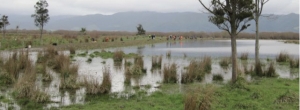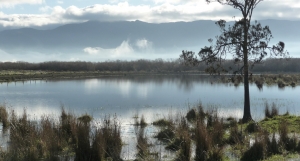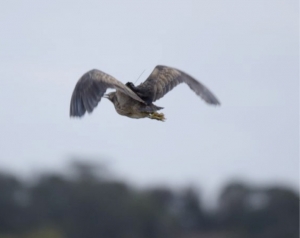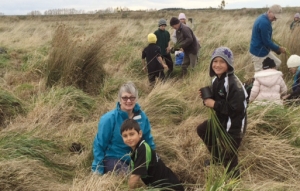Displaying items by tag: Wetlands
Wairio restoration planning and farewell
The presentation of DUNZ’s certificate “in recognition and appreciation of support to NZ’s waterfowl and wetland habitat” to Ian Gunn from Greater Wellington Regional Council (GWRC) – Manager of GWRC’s Wairarapa Moana Project and a great supporter of the Wairio Wetland Restoration Project.
Ian was critical in securing a “step change” in funding for the project. The presentation was made at the end of the meeting along with the small gift of a bottle of wine. DUNZ members may recall Ian joining us at our 2014 AGM in Martinborough.
The recent meeting was held at Fish & Game’s Kilmore Lodge, adjacent to the Wetland where the group planning the 2016 work programme was underway.
Funding currently tots up to around $30,000. Of this, about $20,000 is already funded by contributions from our supporters.
Our wonderful wetlands
This page had a big gap, and because I sometimes do not get enough copy from members or from my web searches I needed a filler. Then I remembered this magic photo taken by Will Abel way back in 2013. Can we remember that far back?
For those of you who have not visited Wario wetlands in southern Wairarapa, just look at the amazing scenery in store for you.
Take your cameras. Ed.
Illegal killing,
Illegal killing,
taking and trade of migratory birds
Each year an estimated 50 billion migratory birds travel thousands of kilometers.
On their migratory routes the birds have to overcome enormous obstacles. One is illegal killing. Many wild birds are illegally taken or killed due to hunting for subsistence, recreational activities and traditional practice.
This year’s World Migratory Bird Day was celebrating the natural miracle of bird migration and is calling for action to end the illegal killing and trade of birds. Illegal hunting leads not only to drastic declines of bird populations, but it also harms society in general, our very existence and our natural resources.
The Ramsar Convention on Wetlands has since its inception in 1971, paid particular attention to migratory birds. Of the current 2,240 Ramsar Sites (covering over 215 million hectares of wetlands worldwide) 1,103 (49 percent of all Sites) have been specifically designated as key sites for migratory waterbirds.
The Ramsar Convention collaborates closely with many international organisations that actively and successfully protect migratory birds across continents.
In Asia, the Ramsar Convention is a partner to the East AsianAustralasian Flyway Partnership, one of the world’s great flyways encompassing 22 countries, extending from Alaska and Arctic Russia down to East Asia and New Zealand. This migration route comprises a network of 124 wetlands, 78 of which are Ramsar Sites. These include Poyang Lake Ramsar Site in China which supports nearly the entire wintering population of Siberian crane. Poyang Lake is also critical for swan goose and other wildfowl and crane species. Mai Po Ramsar Site in Hong Kong is another vital wetland for wintering black-faced spoonbills.
Illegal hunting has recently become a high profile issue within the East Asian-Australasian Flyway especially along the coast of East Asia where a lot of illegal mist nets are being spread. To reduce this trend the Flyway Partnership carries out awareness-raising campaigns and works with local communities. In Southern Asia, local patrolling by forestry offices has brought positive results; there is a big reduction of illegal mist netting.
Spike Millington, East Asian-Australasian Flyway Partnership Chief Executive speaks about threats birds face today and encourages us to take part in bird conservation.
In Europe the Ramsar Convention collaborates with the charitable foundation Euronatur based in Germany and its Adriatic Flyway project. The Adriatic Flyway runs across the Balkan Peninsula down to the African continent. Twice a year millions of birds migrate between their wintering and their breeding grounds on this route.
The most important resting areas and wetlands (Ramsar Sites) along the Adriatic Flyway include: the transboundary Neretva Delta Ramsar Site in Croatia and Hutovo Blato Ramsar Site in Bosnia and Herzegovina; Skadarsko Jezero Ramsar Site in Montenegro and the neighbouring Lake Shkodra and River Buna in Albania; the karst plain Livansko Polje Ramsar Site in Bosnia and Herzegovina and Slano Kopovo Ramsar Site in Serbia.
Particularly during migration periods bird populations are dramatically depleted by bird crime in the western Balkans. Illegal bird hunters make the Eastern Adriatic coast a death trap for migratory birds. 55 percent of migratory wader populations along the Adriatic Flyway are in decline. Law enforcement and control is missing; however in some areas nature conservation NGOs, local communities and administrations are successfully managing important bird areas.
Another European project related to migratory birds is taking place in Greece. Responding to the need to safeguard the rarest waterbird in Europe, in September 2011, the Hellenic Ornithological Society (BirdLife Greece), took on the coordination of an ambitious multistakeholder flyway conservation project. Conservation actions span the entire range of the lesser white-fronted goose in Europe, from its breeding grounds in Scandinavia to its wintering sites in Greece. Hunting and illegal killing are recognised as major threats and patrolling units in Greece were formed to ensure that Kerkini Lake and Evros Delta, both designated Ramsar Sites, remain safe for these geese. In Africa the Ramsar Convention collaborates with African-Eurasian Migratory Waterbird Agreement (AEWA). AEWA brings together countries and the wider international conservation community in an effort to establish coordinated conservation and management of migratory water birds throughout their entire migratory range.
The most important resting areas and wetlands (Ramsar Sites), which are critical for some AEWA species in Africa are the Chad portion of the Lake Chad; Parc national du Banc d’Arguin in Mauritania, where over two million birds winter each year; Parc National du Diawling in Mauritania; Delta du Saloum in Senegal; one of the largest tropical wetlands in the world - the Sudd in Southern Sudan; and finally the Okavango Delta in Botswana.
AEWA and CMS (Convention on Migratory Species of Wild Animals), have undertaken some key actions to end illegal killing of birds in Africa. One of them is a development of a multi-stakeholder Plan of Action to address bird trapping along the Mediterranean coasts of Egypt and Libya. An International Task Force was established in November 2013 in Bonn, Germany, to implement the Plan of Action and to ensure that in future, bird trapping activities in Egypt and Libya will be legal and sustainable.
By joining forces and starting dialogues between all social groups and decision makers involved we can make migratory bird flyways safer places and preserve a healthy and rich environment for humans as well.
Louisiana Wetlands:
Louisiana Wetlands:
Recognising a National Treasure
May 26, 2016 | Posted by Emily McCalla in coastal restoration,
May is American Wetlands Month, and Louisiana’s coastal wetlands are some of the most productive ecosystems in North America. Not only do they provide habitat for numerous fish, wildlife and birds, but they also help improve water quality, provide recreational opportunities and protection for people and infrastructure from damaging storm surges.
Wildlife habitat and nurseries
Wetlands serve as a nursery environment for juvenile fish. The countless ponds, bays and bayous found in the Mississippi River Delta provide essential habitat for most commercial and game fish found in the Gulf of Mexico. Menhaden, shrimp, oysters and blue crab area all important commercial species that depend on healthy coastal wetlands to thrive. Additionally, fur-bearers like muskrat, beaver and mink, as well as reptiles including alligators call coastal wetlands and estuaries home.
Storm surge protection
Wetlands have an incredible value for people, too. One acre of wetlands has the capacity to hold up to 1 million gallons of water during a flood! On average, damaging storm surges are reduced by one foot for every 2.7 miles of wetlands, reducing wave energy and protecting levees and other critical infrastructure from these destructive forces of nature. The value of community protection for a one-mile strip of wetlands is valued at $5.7 million. Water filtration Wetlands also help improve water quality by filtering and retaining residential, agricultural and urban wastes. Reconnection of the Mississippi River to surrounding wetlands would help filter out nutrients that are contribute to a harmful low oxygen area in the Gulf of Mexico dubbed the “dead zone.” The shallow waters of coastal wetlands are good habitat for submerged aquatic vegetation, which can utilise the extra nutrients and potentially reduce the Gulf of Mexico dead zone as well as increasing water clarity.
Restoring Louisiana’s coastal wetlands
Louisiana holds 40 percent of the coastal wetlands in the continental US and is currently experiencing around 80 percent of all coastal wetland loss in the US. Work is underway to restore and rebuild wetlands in the Mississippi River Delta through projects in the state’s Coastal Master Plan, including sediment diversions and marsh creation. The reintroduction of Mississippi River water and sediment to its delta plain allows new wetlands to build and flourish, providing habitat for wildlife, clean water, places to recreate, and protection for storm surge.
Richie Blink, National Wildlife Federation
Robbie at Tootgarook?!
Neil flies 450 km to Moodie Swamp;
Robbie at Tootgarook?!
The following piece was posted in late May this year 2016. Bittern watchers take note…
As if Neil’s spectacular 450 km dispersal wasn’t enough, photos taken in May have watchers wondering which of their other bitterns are down near Melbourne. But first Neil. He left his rice crop at Murrami and flew to Moodie Swamp, a top notch canegrass wetland between Benalla and Yarrawonga in northern Victoria. It was a u-turn of sorts, taking him via the Wakool River between Moulamein and Swan Hill.
Initially they thought he might be heading toward the same area Robbie dispersed at last season, but he made two of his own new connections. They know that the wetlands of northern Victoria and canegrass wetlands are part of the network that sustains the world’s largest known Australasian bittern breeding population. “To think Robbie was in our arms at Murrami just 20 days earlier was amazing.”
Moodie Swamp had recently received environmental water and is well known for its significance to wildlife, not least as a regular Australasian bittern site. While studying Brolgas 16 years ago, I had the pleasure of finding bitterns there and meeting May Moodie. She was a great custodian for this great swamp.
Now, back to Melbourne. One of the bitterns was photographed at the Tootgarook Swamp in May. That’s down around Port Phillip Bay. We know it’s not Neil. We’re trying to work out who it is. Could it be ROBBIE?!
Massive thanks to Cam Brown and Jess Durrant who found this bittern. They both contributed to the crowd funding and joked that one of the tracked bitterns might rock up there. It’s a fitting reward for them and the swamp they love so much. Irrespective of the identity, the link between this most significant wetland near Melbourne and the rice crops of the New South Wales Riverina has been cemented.
World heritage site northern Australia
At Mungalla Stud, a property of 880 hectares there are approximately 230 hectares of seasonally inundated wetlands which are adjacent to the World Heritage Great Barrier Reef and also the IUCN listed Halifax Bay Wetlands National Park.
These wetland have been degraded by invasive plants as a result of installing an earth wall to halt the flow of saline tidal water into the wetlands and by spread in to the wetland of these “weeds of national significance”. This has resulted in major changes to the nutrient regimes, ecosystem stability and function of the wetlands.
While biodiversity and amenity values have been compromised there is excellent capacity for restoration. The Nywaigi Traditional owners have determined to return the wetlands to a more natural state and through a series of projects funded through the Australian Government they have begun the process of rehabilitation.
Since the start of restoration the Mungalla Aboriginal Corporation for Business has concentrated on:
- Weed control on the Annabone Wetlands
- Revegetation Molongo creddk
- Removal of the earth wall
- Weed control in Palm Creek and other fringes.
Mungalla acknowledge and thank the Australian Government for funding and assistance through the Caring for Country programme. Community action Grants and the Biodiversity Fund and they acknowledge the support of the GBRMPA through the Sea Country grants.
“We have benefitted and worked really well with CSIRO who are providing Mungatta Aboriginal Corporation with advice and scientific direction on the rehabilitation and restoration of our wetlands.
This partnership has grown over the last 10 years and we appreciate the support of CSIRO and Dr Tony Grice. And especially acknowledge Mike Nicholas a friend and mentor, and we thank him greatly”.
Jacob Cassady (Director) and Chris Cassady (NRM Manager).
Wairio wetland plant day – another success
June 21 work started at 9am for the organisers, supported by some strong lads from Taratahi Agricultural Training College and farm workers from a local sheep and beef station Palliser Ridge. Those strong farming trainees dug holes in pre-sprayed spots in rough, fescue infested terrain.
Just after 10am we also had about 20 school children from Martinborough and Kahutara primary schools arrive to “assist” in planting flaxes in the holes prepared by the aforementioned lads and workers. In all, around 65 folk helped with the planting and by 12 noon, 750 plants (about half of them kahikatea) were in the ground at the noreastern corner of the Wetland.
Greater Wellington Regional Council provided educational support and the school children, in addition to planting, were treated to a field class identifying plants common to the Wetland. That and the hot sausages for lunch (again provided by GWRC) made a great day for the children who said they would be back next year to see how “their” plants were growing.
Jim Law.
Restoration Day – Success
Restoration Day at Wario May 21, proved to be a success with helpers like Ross Cottle, Ian Gunn, and Tapuwa Marapara, who were able to share their expertise with those who attended.
Adding to the success was the wide diversity of people present, both as presenters and as participants. There were 30 on the bus all up and the combination of talks on the bus and pauses during the field trips gave plenty of time for the story to unfold and for people to ask questions.
The weather played its part too!
It’s all science: Two PhD students, Eve Sutter (wearing hat) and Elisa Piispa, from Victoria University School of Chemistry and Physical Sciences, using an array of electrodes to measure below-ground resistivity at various depths. The technique can be used to estimate the profile of the water table along a transect without the need to dig multiple bore holes.
Stephen Hartley
(Stephen was the organiser).
UNESCO protecting a world heritage site
On July 17 this year, the Marshlands of Southern Iraq, often referred to as the ‘Garden of Eden’, were named a UNESCO World Heritage Site.
The Mesopotamian Marshlands in the lower floodplains of the Euphrates and the Tigris are the largest wetland in the Middle East. The source of the water is upstream in the mountains of Turkey, Iraq and Iran.
The Ahwar of Southern Iraq, as the marshlands were known, are home to hundreds of thousands of birds and at least 40 fish species. The marshes are a stopover point for many birds as they migrate from Central Asia to Africa. These wetlands also play a part in preventing dust storms, which are extremely detrimental to the economy, living conditions and health. They also moderate the temperature in this very hot part of the world. Throughout millennia the area has supported various peoples and their livelihoods, including ancient cultures such as the Sumerians. The World Heritage site unites these natural and cultural aspects.
Wetlands International welcomed the decision to inscribe the marshes on the UNESCO World Heritage List. However, the marshlands face serious constraints to maintain and strengthen the intrinsic values they were inscribed for. The marshes have only partly recovered from severe damage by past drainage and warfare. By 2000, 90 percent of the marshes had been destroyed due to large scale drainage during the Saddam Hussein regime. After the fall of the regime around 40-60 percent of the marshes were re-flooded.
The partially recovered wetlands and the people who depend on them are under threat again from developments such as large dams and agricultural schemes further upstream, which significantly reduce the amount of water flowing to the marshes. Solutions need to be found so the precious river water available is used wisely for the marshes, drinking water and agriculture, and that the oil industry does not compete for water nor pollute the area.
The marshes’ World Heritage status is an important incentive for increased (international) support for the protection of these marshes, including the resources they provide to local people. We hope this nomination will lead to better water management, increased knowledge of its biodiversity values and a sustainable integration of the conservation of the marshlands with social and economic development.
We have been working in this region for many years and were involved in preparing the nomination of the site for World Heritage status. Over the coming years we hope to continue our work to help restore and conserve this iconic wetland and reduce potential impacts from the oil and gas industry.




